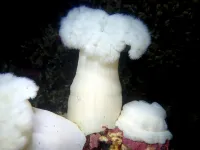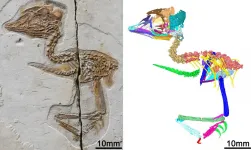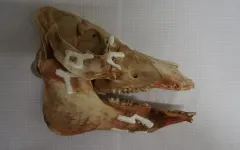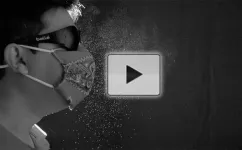(Press-News.org) BUFFALO, N.Y. -- The giant plumose anemone is an animal, but it looks a bit like an underwater cauliflower. Its body consists of a stalk-like column that attaches to rocks and other surfaces on one end, and to a crown of tentacles on the other.
The anemones use these feelers to collect and shove food into their mouths, and a new study provides an in-depth look into the rich diversity of prey the anemones are catching. This includes a surprising menu item: ants, specifically the pale-legged field ant, Lasius pallitarsis. And the occasional spider.
The research was published on June 15 in the journal Environmental DNA. The study focused on giant plumose anemones, known to scientists as Metridium farcimen, that were fixed to the sides and undersides of floating docks in the region of the San Juan Archipelago in the northwestern part of the state of Washington.
The team used a method called DNA metabarcoding to identify the gut contents of a dozen giant plumose anemones. The species' diet was heavy on arthropods, especially crabs (presumably larvae, researchers say), and also included barnacles (larvae or molts), copepods and insects.
"We've greatly expanded the list of things we know that they eat. They're eating whatever they can catch, whatever isn't too big or too small, whatever can't swim away," says first author Christopher Wells, PhD, a postdoctoral researcher in the University at Buffalo Department of Geology. "One of the most surprising results is that in addition to all the usual suspects you'd find in marine plankton, we also found that a part of the diet, about 10% at the time of the study, consisted of ants, which are not marine."
By digging into the natural history of the pale-legged field ant, the researchers came up with a possible explanation for how these ants became part of the marine food chain.
"It's timed with the reproductive portion of the lifespan," Wells says, noting that the study was conducted during the month of August, when the ants have mating flights. "They produce winged queens and drones, which mate and make new colonies. They're not strong fliers and the wind pushes them around, potentially into the water."
The team's results indicate that giant plumose anemones also eat the occasional hapless spider, along with a few insects in addition to ants that may wander too close to the water's edge and drown.
The study was a collaboration between Wells; Gustav Paulay, PhD, at the Florida Museum of Natural History; Bryan Nguyen, PhD, at George Washington University; and Matthieu Leray, PhD, at the Smithsonian Tropical Research Institute. Wells, now in the Department of Geology in the UB College of Arts and Sciences, conducted the research at Friday Harbor Laboratories while completing a PhD at the University of Washington.
By extracting genetic material from a slushy mix of partially digested food, the researchers were able to work backward, comparing their results to information stored in databases about the DNA of varied organisms.
"Part of our research was using this method, DNA metabarcoding, and comparing it to traditional techniques where you wash out or cut open an anemone and then identify what you can see. The trouble is when you do that, you can't identify everything," Wells says. "You might say, 'That looks like it's a copepod antenna,' but you can't tell what species it is.
With DNA metabarcoding, you can identify what species' antennae that is. We were able to identify a lot more diversity using metabarcoding."
Knowing what an animal eats is indispensable when trying to understand how marine communities function.
"When a plankton community floats overtop a bed of anemones, the plankton is filtered by millions of grasping tentacles," Wells says. "This can drastically change the composition of the plankton community, which is food for many economically important animals such as bivalves and fish."
Anemones found in close proximity to one another had varied diets, but, "I don't think that's because they're choosing different things to eat," Wells says. "They eat what they can, and it's very patchy what they get, depending on what's there."
While the researchers were able to identify many of the species preyed on by the giant plumose anemone, Paulay, curator of invertebrate zoology at the Florida Museum of Natural History, noted they were unable to match a substantial portion of DNA sequences with any known organisms, underscoring how much is left to be discovered in the oceans.
INFORMATION:
The research was supported by the Robert T. Paine Experimental and Field Ecology Award Fellowship; Friday Harbor Laboratories Research Fellowship Endowment and Marine Science Fund; Patricia L. Dudley Endowment for Friday Harbor Laboratories; Richard and Megumi Strathmann Fellowship; and Kenneth P. Sebens Endowed Student Support Fund.
How long do virus-laden particles persist in an elevator after a person infected with COVID-19 leaves? And is there a way to detect those particles? A group of electrical engineers and computer scientists at KAUST set out to answer these questions using mathematical fluid dynamics equations.
"We found1 that virus-laden particles can still be detected several minutes after a short elevator trip by an infected person," says KAUST electrical engineer Osama Amin.
The team's equations and breath simulations suggest that a biosensor's ability to detect a virus improves when placed on an elevator wall that can reflect particles. Also, to protect future occupants, the amount of particles in the air can be reduced by making the other three walls absorptive.
Amin ...
COLUMBIA, Mo. - Throughout her 20-year career as a nurse practitioner, Jennifer Hulett noticed survivors of breast cancer would often express gratitude for being alive and mention God or a divine acknowledgement that had improved their health and well-being.
Now an assistant professor at the University of Missouri Sinclair School of Nursing, Hulett is researching the benefits of spirituality on improving immune health and reducing stress, as well as the chances of cancer reoccurrence, among breast cancer survivors.
In a recent study, Hulett collected and froze samples of saliva from 41 breast cancer survivors at MU's Ellis Fischel Cancer Center. ...
Researchers from the Institute of Vertebrate Paleontology and Paleoanthropology (IVPP) of the Chinese Academy of Sciences have discovered a 120-million-year-old partial fossil skeleton of a tiny extinct bird that fits in the palm of the hand and preserves a unique skull with a mix of dinosaurian and bird features.
The two-centimeter-long (0.75 inch) skull of the fossil shares many structural and functional features with the gigantic Tyrannosaurus rex, indicating that early birds kept many features of their dinosaurian ancestors and their skulls functioned much like those of dinosaurs rather than living ...
MINNEAPOLIS/ST. PAUL (06/23/2021) -- A new report from the University of Minnesota Medical School's Healthy Youth Development - Prevention Research Center (HYD-PRC) highlights that Minnesota youth continue to contract sexually transmitted infections (STIs) at alarmingly high rates, despite the COVID-19 pandemic.
The 2021 Minnesota Adolescent Sexual Health Report says that chlamydia and gonorrhea rates among Minnesota adolescents in 2020 are likely underreported, as both STI testing and case detection were scaled back during the early stages of the pandemic. However, teen pregnancy rates remain virtually unchanged from 2018, and birth rates are at historic lows for ...
The stink of ammonia in urine, sweat, and rotting meat repels humans, but many insects find ammonia alluring. Now, UConn researchers have figured out how the annoying insects smell it, a discovery that could lead to better ways to make them buzz off.
The sense of smell is enormously important. Mammals devote a third of their genetic code to odor receptors found in the nose, and have more than 1,000 different kinds that allow us to smell an estimated trillion different odors.
Flies don't have noses. Instead, they smell with their antenna. Each antenna is covered with tiny hairs called sensilla. Each sensilla contains a few neurons--fly brain cells. Each neuron expresses one type of odor receptor, and they all fall into two main ...
A new biocompatible polymer-based composite material could soon replace metal plates in treating difficult and unstable fractures. Developed at KTH Royal Institute of Technology in Stockholm, the newly-developed material is as strong as dental composites yet non-toxic.
The material and a surgical method, which were published in Advanced Functional Materials, will be used in clinical studies in 2023 and 2024, with a focus on hand fractures.
Michael Malkoch, professor of fibre and polymer technology at KTH, says that the material and method, AdhFix, will enable customized plating for fixation of fractures with a more comfortable, less complicated recovery. Collarbone and rib fractures in particular are ideally suited for the proposed treatment, ...
During the COVID-19 pandemic, cloth face masks became a way to help protect yourself and others from the virus. And for some people, they became a fashion statement, with many fabric choices available. But just how effective are they, especially in containing a sneeze? Now, researchers reporting in ACS Biomaterials Science & Engineering used high-speed videos of a person sneezing to identify the optimal cloth mask design. Watch a video of the sneeze cam here.
Early in the pandemic, worldwide shortages of surgical masks and N95 respirators led many people to make or purchase cloth face masks. Now, with safe and effective COVID-19 vaccines available, mask restrictions are ...
A new study published in the Journal of the Association for Consumer Research posits that increased accessibility to anthropomorphized luck (i.e., "lady luck") can lead consumers to be more likely to pursue higher-risk financial behavior. In "Lady Luck: Anthropomorphized Luck Creates Perceptions of Risk-Sharing and Drives Pursuit of Risky Alternatives," authors Katina Kulow, Thomas Kramer, and Kara Bentley propose that preferences for higher-risk options (like lottery tickets with worse odds or investment opportunities with a low chance of return) are driven by shared risk perceptions that might engender feelings of security provided by the idea of "lady luck." This behavior, the authors note, "bodes ill for consumer welfare, given that many financial maladaptive activities ...
Beyond how much cream and sugar to add to their morning brew, coffee lovers also face more serious decisions: one of those is whether or not to buy ecolabelled coffee, which advertises itself as more ethical and environmentally friendly. But whether customers are willing to pay the extra price for these perks remains an unanswered question. In a study publishing in the journal Heliyon on June 23, researchers combined data from 22 studies to conclude that in general, people are willing to pay $1.36 more for a pound of coffee that's produced in an eco-friendly way and are especially partial to coffee that's labelled "Organic."
"We hear in the media or sometimes read in the newspaper that there ...
Researchers have developed a simple lab-based technique that allows them to look inside lithium-ion batteries and follow lithium ions moving in real time as the batteries charge and discharge, something which has not been possible until now.
Using the low-cost technique, the researchers identified the speed-limiting processes which, if addressed, could enable the batteries in most smartphones and laptops to charge in as little as five minutes.
The researchers, from the University of Cambridge, say their technique will not only help improve existing battery materials, ...





